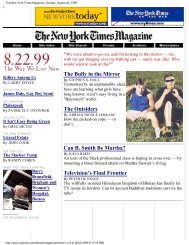The New York Times Magazine, Sunday, August 22, 1999
The New York Times Magazine, Sunday, August 22, 1999
The New York Times Magazine, Sunday, August 22, 1999
Create successful ePaper yourself
Turn your PDF publications into a flip-book with our unique Google optimized e-Paper software.
<strong>The</strong> Outsiders<br />
whose regional high school, ConVal, sits in Peterborough, N.H., the setting that<br />
inspired Thornton Wilder's "Our Town." But what it shares with those other<br />
places, and with countless others across the country, is a brutally enforced<br />
teen-age social structure.<br />
Below the<br />
popular kids, in a<br />
shifting order of<br />
relative<br />
unimportance,<br />
are the druggies,<br />
trendies,<br />
preppies,<br />
skateboarders,<br />
nerds and<br />
techies, wiggers,<br />
rednecks and<br />
Goths, better<br />
known as freaks.<br />
Real losers are<br />
invisible.<br />
Boys at the bottom of the pyramid use different<br />
strategies to cope -- turning inward and outward,<br />
sometimes in highly destructive ways. (<strong>The</strong>re has<br />
been a fivefold jump in the homicide and suicide<br />
rates of boys in the last 40 years, a rise some experts<br />
attribute to increasing male depression and anger as<br />
well as access to guns, among other factors.) Most<br />
boys live through it, suffer, survive. But the journey<br />
may be especially deadly now because, as the<br />
avalanche of new "male identity" literature<br />
demonstrates, the old prescriptions for behavior no<br />
longer hold, and the new ones are ambivalent.<br />
Today's young males may be feminism's children,<br />
but no one is comfortable with openhearted or<br />
vulnerable boys.<br />
ConVal is in some ways progressive. <strong>The</strong>re are<br />
about 900 students and an administration that<br />
consciously works to minimize the ultramacho<br />
sports culture that dominates many schools. Says<br />
Bob Marshall, the head of the social studies<br />
department, who founded the football program in<br />
1992: "We had to create a football culture. People<br />
didn't know when to cheer. We didn't even have a school song."<br />
Even so, the traditional hierarchies operate: the popular kids tend to be wealthier<br />
and the boys among them tend to be jocks. <strong>The</strong> Gap Girls-Tommy Girls-Polo<br />
Girls compose the pool of desirable girlfriends, many of whom are athletes as<br />
well. Below the popular kids, in a shifting order of relative unimportance, are the<br />
druggies (stoners, deadheads, burnouts, hippies or neo-hippies), trendies or<br />
Valley Girls, preppies, skateboarders and skateboarder chicks, nerds and techies,<br />
wiggers, rednecks and Goths, better known as freaks. <strong>The</strong>re are troublemakers,<br />
losers and floaters -- kids who move from group to group. Real losers are<br />
invisible.<br />
Bullying, here as elsewhere, is rampant. Even in small-town, supposedly safe<br />
environments like Peterborough, a 1994 study found, the vast majority of kids<br />
from middle school up are bullied by their peers. <strong>The</strong> shaming is sex-based, but<br />
the taunting is more intense for boys -- an average high-school student,<br />
http://www.nytimes.com/library/magazine/home/<strong>1999</strong>08<strong>22</strong>mag-boys-social-coping.html (3 of 13) [8/<strong>22</strong>/<strong>1999</strong> 9:18:<strong>22</strong> PM]






